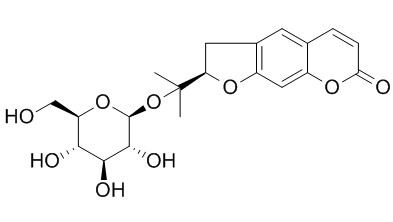Natural Products
Nodakenin
| Catalog No. | CFN90232 |  |
| CAS No. | 495-31-8 | |
| Molecular Weight: | 408.40 | |
| Molecular Formula | C20H24O9 | |
| DBs | [PubChem]:274950410 [ChEMBL]:7607 [PCIDB]:2486 |
Standard InChI:
InChI=1S/C20H24O9/c1-20(2,29-19-18(25)17(24)16(23)13(8-21)28-19)14-6-10-5-9-3-4-15(22)27-11(9)7-12(10)26-14/h3-5,7,13-14,16-19,21,23-25H,6,8H2,1-2H3/t13?,14-,16-,17+,18?,19+/m1/s1
Biological Activity
Nodakenin, a coumarin isolated from the roots of Angelica biserrata (Shan et Yuan) Yuan etShan, possesses neuroprotective, antiaggregatory, antibacterial, and memory
-enhancing effects; down-regulates the expression of the proinflammatory iNOS, COX-2, TNF-α, IL-6, and IL-1β genes in macrophages by interfering with the activation of TRAF6, thus preventing NF-κB activation.[1]
Nodakenin can inhibit acetylcholinesterase activity in a dose-dependent manner (IC(50)=84.7 microM), nodakenin may be a useful for the treatment of cognitive impairment, and that its beneficial effects are mediated, in part, via the enhancement of cholinergic signaling.[2]
Nodakenin efficiently inhibits antigen-induced airway inflammation in asthmatic mouse, by reducing levels of IL-4,IL-5 and IL-13 in BALF,and IgE in serum,decreasing levels of nuclear P65 and p-P65 protein,increasing cytoplasmic P65 and IκBα protein,and NF-κB DNA binding activity. [3]
Nodakenin can inhibit mast cell degranulation through the inhibition of IL-4 and TNF-α mRNA expression, and that nodakenin may potentially serve as an anti-allergic agent.[4]
Nodakenin may be a potential therapeutic resource for AD as well as an adjunctive agent to control associated with AD, by suppressing the increase of AD-like skin lesions in ICR.[5]
Product
References
[1] Rim H K, Cho W, Sung S H, et al. J Pharmacol Exp Ther, 2012, 342(3):654-64.
[2] Dong H K, Kim D Y, Kim Y C, et al. Life Sci , 2007, 80(21):1944-50.
[3] Xiong Y Y, Shi W J, Hao Y U, et al. Basic & Clinical Medicine, 2014.
[4] Kim Y J, Park S J, Kim T J. 생명과학회지, 2011, 21:1721-1725.
[5] Park S J, Cha H S, Lee Y H, et al. Biosci BiotechI Bioch, 2014, 78(9):1568-71.
[6] Zhang P, Yang X W. J Asian Nat Prod Res, 2009, 11(4):371-9.
Product Use Citation





